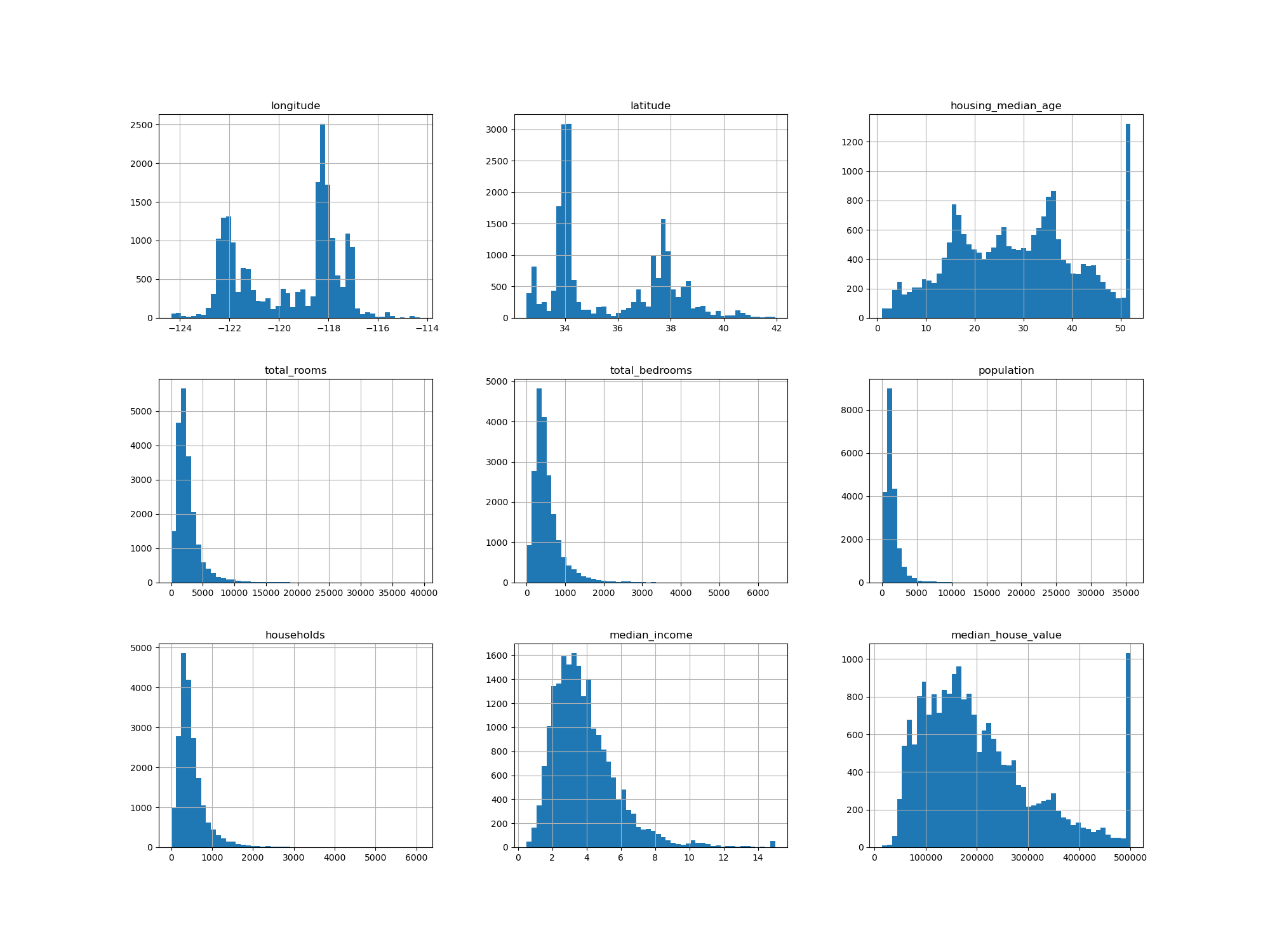Handson machin learning part1을 보고 정리한 내용입니다
머신러닝 프로젝트 진행 순서
- 큰 그림을 본다
- 데이터를 구한다
- 데이터로부터 통찰을 얻기 위해 탐색하고 시각화한다
- 머신러닝 알고리즘을 위해 데이터를 준비한다
- 모델을 선택하고 훈련한다
- 모델을 상세하게 조정한다
- 솔루션을 제시한다
- 시스템을 론칭하고 모니터링하고 유지보수한다
chapter 2에서는
StatLib저장소에 있는 캘리포니아 주택 가격 데이터셋을 사용한다
데이터 다운로드
1
2
3
4
5
6
7
8
9
10
11
12
13
14
15
import os
import tarfile
import urllib
DOWNLOAD_ROOT = 'https://raw.githubusercontent.com/ageron/handson-ml2/master/'
HOUSING_PATH = os.path.join('datasets', 'housing')
HOUSING_URL = DOWNLOAD_ROOT + 'datasets/housing/housing.tgz'
def fetch_housing_data(housing_url=HOUSING_URL, housing_path=HOUSING_PATH):
os.makedirs(housing_path, exist_ok=True)
tgz_path = os.path.join(housing_path, 'housing.tgz')
urllib.request.urlretrieve(housing_url, tgz_path)
housing_tgz = tarfile.open(tgz_path)
housing_tgz.extractall(path=housing_path)
housing_tgz.close()
fetch_housing_data()를 호출하면 현재 작업공간에datasets/housing폴더를 생성하고housing.tgz파일을 내려받고 같은 폴더에 압축을 풀어housing.csv를 만든다
1
2
3
4
5
import pandas as pd
def load_housing_data(housing_path=HOUSING_PATH):
csv_path = os.path.join(housing_path, 'housing.csv')
return pd.read_csv(csv_path)
load_housing_data함수를 사용해 모든 데이터를 담은 판다스의 데이터프레임 객체를 반환한다
데이터 확인해보기
1
2
3
4
5
6
7
8
9
10
11
12
13
14
15
16
17
18
19
20
21
22
23
24
25
26
27
28
29
30
31
32
from download_data import *
housing = load_housing_data()
print(housing.head())
print(housing.info())
--------------------------------
longitude latitude ... median_house_value ocean_proximity
0 -122.23 37.88 ... 452600.0 NEAR BAY
1 -122.22 37.86 ... 358500.0 NEAR BAY
2 -122.24 37.85 ... 352100.0 NEAR BAY
3 -122.25 37.85 ... 341300.0 NEAR BAY
4 -122.25 37.85 ... 342200.0 NEAR BAY
[5 rows x 10 columns]
<class 'pandas.core.frame.DataFrame'>
RangeIndex: 20640 entries, 0 to 20639
Data columns (total 10 columns):
# Column Non-Null Count Dtype
--- ------ -------------- -----
0 longitude 20640 non-null float64
1 latitude 20640 non-null float64
2 housing_median_age 20640 non-null float64
3 total_rooms 20640 non-null float64
4 total_bedrooms 20433 non-null float64
5 population 20640 non-null float64
6 households 20640 non-null float64
7 median_income 20640 non-null float64
8 median_house_value 20640 non-null float64
9 ocean_proximity 20640 non-null object
dtypes: float64(9), object(1)
memory usage: 1.6+ MB
None
- 이전 pandas 포스팅을 떠올리며 데이터를 확인해 보았다
head()를 사용해 데이터 상위 5개의 데이터를 조회한다info()를 사용해 데이터에 대한 간단한 설명과 전체 행 수, 각 특성의 데이터 타입과NULL이 아닌 값의 개수를 확인하는데에 사용한다
1
2
3
4
5
6
7
8
9
ocean_proximity = housing['ocean_proximity'].value_counts()
print(ocean_proximity)
---------------------------------------------------
<1H OCEAN 9136
INLAND 6551
NEAR OCEAN 2658
NEAR BAY 2290
ISLAND 5
Name: ocean_proximity, dtype: int64
info()에서 확인한ocean_proximity의 데이터 타입은object(텍스트)이다- 텍스트 데이터 타입이므로 특성이
categorical한 것을 예상해 볼 수 있다 value_counts()를 사용해 각 카테고리가 얼마나 존재하는지 알 수 있다
1
2
3
4
5
6
7
8
9
10
11
12
13
housing.describe()
-------------------
longitude latitude ... median_income median_house_value
count 20640.000000 20640.000000 ... 20640.000000 20640.000000
mean -119.569704 35.631861 ... 3.870671 206855.816909
std 2.003532 2.135952 ... 1.899822 115395.615874
min -124.350000 32.540000 ... 0.499900 14999.000000
25% -121.800000 33.930000 ... 2.563400 119600.000000
50% -118.490000 34.260000 ... 3.534800 179700.000000
75% -118.010000 37.710000 ... 4.743250 264725.000000
max -114.310000 41.950000 ... 15.000100 500001.000000
[8 rows x 9 columns]
describe()를 사용해 숫자형 특성을 가진 데이터의 요약 정보를 보여준다
데이터 히스토그램 확인
1
2
housing.hist(bins=50, figsize=(20, 15))
plt.show()
matplotlib을 import 해주고hist()를 이용해 데이터의 히스토그램을 그릴 수 있다
테스트 세트 만들기
데이터 스누핑 편향
- 테스트 세트를 알고 있다면 테스트 세트의 패턴을 인지하고 특정 머신러닝 모델을 사용하게 될 수 있다
- 테스트 세트로 일반화 오차를 추정하면 높은 성능이 나오며 서비스 론칭 시 기대한 성능이 나오지 않을 수 있다
계층적 샘플링
- 순수하게 무작위로 샘플링하는 방식은 샘플링 편향이 생길 수 있다
- 예를들어 설문조사를 하면 무작위로 사람을 뽑지 않고 각 그룹을 대표할 수 있게 비율을 맞춰 뽑는다
- 계층적 샘플링은 테스트 세트가 전체 인구(현재 예제)를 대표하도록 각 계층에서 올바른 수의 샘플을 추출한다
소득 카테고리 기반 계층 샘플링
1
2
3
4
5
6
7
8
9
10
11
12
13
14
15
16
def train_test():
'''소득 카테고리를 기반으로 계층 샘플링'''
housing['income_cat'] = pd.cut(housing['median_income'],
bins=[0., 1.5, 3.0, 4.5, 6., np.inf],
labels=[1, 2, 3, 4, 5])
strat_test_set, strat_train_set = [], []
split = StratifiedShuffleSplit(n_splits=1, test_size=0.2, random_state=42)
for train_index, test_index in split.split(housing, housing['income_cat']):
strat_train_set = housing.loc[train_index]
strat_test_set = housing.loc[test_index]
for set_ in (strat_train_set, strat_test_set):
set_.drop('income_cat', axis=1, inplace=True)
return strat_train_set, strat_test_set
상관관계 조사
1
2
3
4
5
6
7
8
9
10
11
12
13
corr_matrix = housing.corr()
house_price = corr_matrix['median_house_value'].sort_values(ascending=False)
----------------------------
median_house_value 1.000000
median_income 0.688075
total_rooms 0.134153
housing_median_age 0.105623
households 0.065843
total_bedrooms 0.049686
population -0.024650
longitude -0.045967
latitude -0.144160
Name: median_house_value, dtype: float64
- 중간 주택 가격과 다른 특성 사이의 상관관계 크기를 알 수 있다
- 상관관계의 범위는 -1에서 1까지이며 1에 가까울수록 강한 양의 상관관계를 가진다
- 계수가 0에 가까우면 선형적인 상관관계가 없다는 뜻이다
머신러닝 알고리즘을 위한 데이터 준비
데이터 정제
- 머신러닝 알고리즘은 누락된 특성을 다루지 못한다
total_bedrooms특성에 값이 누락되어 있는데 이를 해결할 방법은 세 가지이다- 해당 구역을 제거
- 전체 특성을 삭제
- 값으로 채우기 (중간값, 0, 평균)
1
2
3
4
5
6
housing.dropna(subset=['total_bedrooms']) # 옵션 1
housing.drop('total_bedrooms', axis=1) # 옵션 2
# 중간값
median = housing['total_bedrooms'].median() # 옵션 3
housing['total_bedrooms'].fillna(median, inplace=True)
- 중간값은 시스템 평가 시 누락된 값과 시스템 실제 운영 시 누락값을 채우기 위한것이다
sklearn SimpleImputer
1
2
3
4
5
6
7
8
# 중간값으로 대체
imputer = SimpleImputer(strategy='median')
# 수치형 특성에만 계산될 수 있으므로 object 특성 제외
housing_num = housing.drop('ocean_proximity', axis=1)
imputer.fit(housing_num)
X = imputer.transform(housing_num)
housing_tr = pd.DataFrame(X, columns=housing_num.columns, index=housing_num.index)
strategy속성을 “median”으로 설정해 중간값으로 대체해준다ocean_proximity는 수치형 특성이 아니기에 제외하고 저장해준다- imputer는 각 특성의 중간값을 계산해 결과를 객체의
statistics_속성에 저장한다 X는 평범한 넘파이 배열이므로 판다스 데이터프레임으로 되돌릴 수 있다
텍스트와 범주형 특성 다루기
1
2
3
4
5
6
7
8
9
10
11
12
13
14
15
16
17
18
19
ordinal_encoder = OrdinalEncoder()
housing_cat_encoded = ordinal_encoder.fit_transform(housing_cat)
------------------------------
[[3.]
[3.]
[3.]
[3.]
[3.]]
cat_encoder = OneHotEncoder()
housing_cat_1hot = cat_encoder.fit_transform(housing_cat)
---------------------------------
[[0. 0. 0. 1. 0.]
[0. 0. 0. 1. 0.]
[0. 0. 0. 1. 0.]
...
[0. 1. 0. 0. 0.]
[0. 1. 0. 0. 0.]
[0. 1. 0. 0. 0.]] # toarray() 사용해서 출력한 것
OrdinalEncoder은 카테고리를 텍스트에서 숫자로 변환해서 표현해준다OneHotEncoder는 1이 하나이고 나머지가 0인 배열로 반환해주고toarray()메서드를 호출하면 넘파이 배열로 나타낼 수 있다ordinal_encoder와cat_encoder의categories_인스턴스를 사용하면 어떤 카테고리가 있는지 알 수 있다
나만의 변환기
1
2
3
4
5
6
7
8
9
10
11
12
13
14
15
16
17
18
19
20
21
rooms_ix, bedrooms_id, population_ix, households_ix = 3, 4, 5, 6
class CombineAttributesAdder(BaseEstimator, TransformerMixin):
def __init__(self, add_bedrooms_per_room=True):
self.add_bedrooms_per_room = add_bedrooms_per_room
def fit(self, X, y=None):
return self
def transform(self, X):
rooms_per_household = X[:, rooms_ix] / X[:, households_ix]
population_per_household = X[:, population_ix] / X[:, households_ix]
if self.add_bedrooms_per_room:
bedrooms_per_room = X[:, bedrooms_id] / X[:, households_ix]
return np.c_[
X, rooms_per_household, population_per_household, bedrooms_per_room]
else:
return np.c_[X, rooms_per_household, population_per_household]
attr_adder = CombineAttributesAdder(add_bedrooms_per_room=False)
housing_extra_attribs = attr_adder.transform(housing.values)
- 사이킷런이 다양한 변환기를 제공하지만 어떤 특성을 조합하는 등의 작업이 필요해 직접 변환기를 만들어야 할 필요가 생긴다
class를 구현하고fit과transform()을 만들어 구현한다- 조합 특성을 추가하는 간단한 변환기이다
- 데이터 준비 단계에서 자동화할수록 더 많은 조합을 시도할 수 있으며 최상의 조합을 찾을 가능성이 높다 (시간도 절약된다!!)
특성 스케일링
- 모든 특성의 범위를 같도록 만들어주는 방법으로
min-max스케일링과 표준화가 사용된다
변환 파이프라인
1
2
3
4
5
6
7
num_pipeline = Pipeline([
('imputer', SimpleImputer(strategy='median')),
('attribs_adder', CombineAttributesAdder()),
('std_scaler', StandardScaler())
])
# 파이프라인의 fit 메서드 실행
housing_num_tr = num_pipeline.fit_transform(housing_num)
sklearn에는 연속된 변환을 순서대로 처리할 수 있도록 도와주는Pipeline클래스가 있다Pipeline은 연속된 단계를 나타내는 이름/추정기 쌍의 목록을 입력으로 받는다- 마지막 단계에는 변환기와 추정기를 모두 사용할 수 있어야 하고 이외에는 모두 변환기여야 한다 (
fit_transform()메서드를 가지고 있어야 한다) - 파이프라인의
fit()메서드를 호출하면 모든 변환기의fit_transform()메서드를 순서대로 호출하며 한 단계의 출력을 다음 단계의 입력으로 전달한다, 마지막 단계에서는fit()메서드만 호출한다 - 파이프라인 객체는 마지막 추정기와 동일한 메서드를 제공한다
1
2
3
4
5
6
7
8
9
10
11
from sklearn.compose import ColumnTransformer
num_attribs = list(housing_num)
cat_attribs = ['ocean_proximity']
full_pipeline = ColumnTransformer([
('num', num_pipeline, num_attribs),
('cat', OneHotEncoder(), cat_attribs)
])
housing_prepared = full_pipeline.fit_transform(housing)
ColumnTransformer를 이용해 하나의 변환기로 각 열마다 적절하게 변환을 적용해 모든 열을 처리할 수 있다
모델 선택과 훈련
훈련 세트에서 훈련하고 평가하기
Linear Regression
1
2
3
4
5
from sklearn.linear_model import LinearRegression
lin_reg = LinearRegression()
lin_reg.fit(housing_prepared, housing_labels)
# RMSE: 68628.19819848923
k-fold cross-validation
1
2
3
4
5
6
from sklearn.model_selection import cross_val_score
scores = cross_val_score(tree_reg, housing_prepared, housing_labels,
scoring="neg_mean_squared_error", cv=10)
tree_rmse_scores = np.sqrt(-scores)
# RMSE: 0.0
Random Forest
1
2
3
4
5
from sklearn.ensemble import RandomForestRegressor
forest_reg = RandomForestRegressor(n_estimators=100, random_state=42)
forest_reg.fit(housing_prepared, housing_labels)
# RMSE: 18603.515021376355
housing_prepared과housing_labels을 각 모델의 입력으로 사용해 간단하게 모델을 훈련할 수 있다
모델 저장하기
1
2
3
4
5
import joblib
my_model = ''
joblib.dump(my_model, 'my_model.pkl')
my_model_loaded = joblib.load('my_model.pkl')
모델 세부 튜닝
- 가능성 있는 모델을 추렸다고 가정하고 모델을 세부 튜닝을 한다
그리드 탐색
1
2
3
4
5
6
7
8
9
10
11
12
13
14
15
from sklearn.model_selection import GridSearchCV
param_grid = [
# 12(=3×4)개의 하이퍼파라미터 조합을 시도합니다.
{'n_estimators': [3, 10, 30], 'max_features': [2, 4, 6, 8]},
# bootstrap은 False로 하고 6(=2×3)개의 조합을 시도합니다.
{'bootstrap': [False], 'n_estimators': [3, 10], 'max_features': [2, 3, 4]},
]
forest_reg = RandomForestRegressor(random_state=42)
# 다섯 개의 폴드로 훈련하면 총 (12+6)*5=90번의 훈련이 일어납니다.
grid_search = GridSearchCV(forest_reg, param_grid, cv=5,
scoring='neg_mean_squared_error',
return_train_score=True)
grid_search.fit(housing_prepared, housing_labels)
GridSearchCV을 사용해 랜덤 포레스트 모델의 가능한 모든 하이퍼 파라미터 조합에 대해 교차 검증을 사용해 평가하게 된다
1
2
3
4
5
6
7
8
9
10
11
12
13
grid_search.best_params_
--------------------------
{'max_features': 8, 'n_estimators': 30}
grid_search.best_estimator_
-------------------------
RandomForestRegressor(bootstrap=True, ccp_alpha=0.0, criterion='mse',
max_depth=None, max_features=8, max_leaf_nodes=None,
max_samples=None, min_impurity_decrease=0.0,
min_impurity_split=None, min_samples_leaf=1,
min_samples_split=2, min_weight_fraction_leaf=0.0,
n_estimators=30, n_jobs=None, oob_score=False,
random_state=42, verbose=0, warm_start=False)
best_params_로 최적의 조합을 얻을 수 있다best_estimator_로 최적의 추정기를 확인할 수 있다GridSearchCV의refit=True로 초기화되었다면 교차 검증으로 최적의 추정기를 찾고 전체 훈련 세트로 다시 훈련시킨다. 이 방법은 많은 데이터를 사용하기에 성능 향상에 도움이 된다
1
2
3
cvres = grid_search.cv_results_
for mean_score, params in zip(cvres["mean_test_score"], cvres["params"]):
print(np.sqrt(-mean_score), params)
- 그리드 서치에서 테스트한 하이퍼파라미 조합들의 점수를 확인할 수 있다
랜덤 탐색
- 하이퍼파라미터 탐색 공간이 커지면
RandomizedSearchCV를 사용하는것이 좋다 - 랜덤 탐색을 1000회 반복하도록 실행하면 하이퍼파라미터마다 각각 다른 1000개의 값을 탐색한다
- 반복횟수를 조절하는것으로 하이퍼파라미터 탐색에 투입할 컴퓨팅 자원을 제어할 수 있다
앙상블 방법
- 최상의 모델을 연결해보는것이다
- 모델의 그룹이 최상의 단일 모델보다 더 좋은 성능을 낼 수 있다
- 결정 트리의 앙상블인 랜덤 포레스트가 결정 트리 하나보다 좋은 성능을 보이는것을 예로 들 수 있다
최상의 모델과 오차 분석
1
2
3
4
5
6
7
8
9
10
11
12
13
14
15
16
17
18
19
20
21
22
23
24
25
feature_importances = grid_search.best_estimator_.feature_importances_
extra_attribs = ["rooms_per_hhold", "pop_per_hhold", "bedrooms_per_room"]
#cat_encoder = cat_pipeline.named_steps["cat_encoder"] # 예전 방식
cat_encoder = full_pipeline.named_transformers_["cat"]
cat_one_hot_attribs = list(cat_encoder.categories_[0])
attributes = num_attribs + extra_attribs + cat_one_hot_attribs
sorted(zip(feature_importances, attributes), reverse=True)
------------------------------------------------
[(0.36615898061813423, 'median_income'),
(0.16478099356159054, 'INLAND'),
(0.10879295677551575, 'pop_per_hhold'),
(0.07334423551601243, 'longitude'),
(0.06290907048262032, 'latitude'),
(0.056419179181954014, 'rooms_per_hhold'),
(0.053351077347675815, 'bedrooms_per_room'),
(0.04114379847872964, 'housing_median_age'),
(0.014874280890402769, 'population'),
(0.014672685420543239, 'total_rooms'),
(0.014257599323407808, 'households'),
(0.014106483453584104, 'total_bedrooms'),
(0.010311488326303788, '<1H OCEAN'),
(0.0028564746373201584, 'NEAR OCEAN'),
(0.0019604155994780706, 'NEAR BAY'),
(6.0280386727366e-05, 'ISLAND')]
feature_importances_는 정확한 예측을 만들기 위한 각 특성의 상대적 중요도를 보여준다- 이 정보를 통해 덜 중요한 데이터의 특성들을 제외할 수 있다
테스트 세트로 시스템 평가하기
1
2
3
4
5
6
7
8
9
10
final_model = grid_search.best_estimator_
X_test = strat_test_set.drop("median_house_value", axis=1)
y_test = strat_test_set["median_house_value"].copy()
X_test_prepared = full_pipeline.transform(X_test)
final_predictions = final_model.predict(X_test_prepared)
final_mse = mean_squared_error(y_test, final_predictions)
final_rmse = np.sqrt(final_mse)
- 테스트 세트에서 훈련을 하면 안되기 때문에
fit_transform()이 아닌transform()을 호출해야 한다
1
2
3
4
5
6
7
from scipy import stats
confidence = 0.95
squared_errors = (final_predictions - y_test) ** 2
np.sqrt(stats.t.interval(confidence, len(squared_errors) - 1,
loc=squared_errors.mean(),
scale=stats.sem(squared_errors)))
scipy.stats.t.interval()을 사용해 일반화 오차의 95% 신뢰 구간을 계산할 수 있다- 테스트 세트에서는 성능을 향상시키려고 하이퍼파라미터 튜닝을 시도하면 안된다

